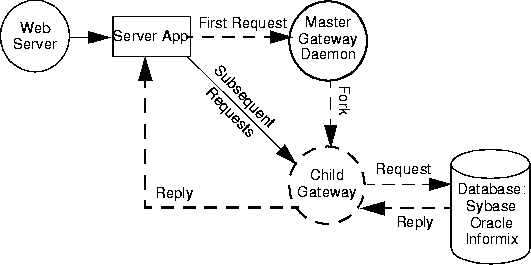[Top] [Prev] [Next] [Bottom]
[Contents]
How Sapphire/Gateway Works
The Gateway daemon can run on as many network machines as desired. It can even run multiple daemons on a single machine, although this is seldom necessary.
When your Web server executes the Server Application, several steps take place.
- 1. The Server Application sends request(s) to the Gateway daemon that was started.
- 2. The master daemon receives the request and forks off a child which handles all requests for the Server Application.
- 3. The new child Gateway notifies the child of its RPC location and proceeds to contact the database.
- 4. The connection between the Gateway and the Database is vendor specific. Each database has its own network layer that is independent of the Gateway to Server Application interface. In essence the Gateway is a client of the Database with which it is communicating.
- 5. Once the request has been processed by the Database, its status and/or results are passed back to the child Gateway.
- 6. The child Gateway proceeds to send all of the results as status information to the Server Application.
- 7. Subsequent requests go directly to the child Gateway, and repeat the above procedure until all of the requests are completed. At this time, the Server Application notifies the child Gateway to exit and proceeds to exit itself.
The following diagram describes the flow of a Gateway request:

[Top] [Prev] [Next] [Bottom]
[Contents]
info@bluestone.com
Copyright © 1997, Bluestone. All rights
reserved.
